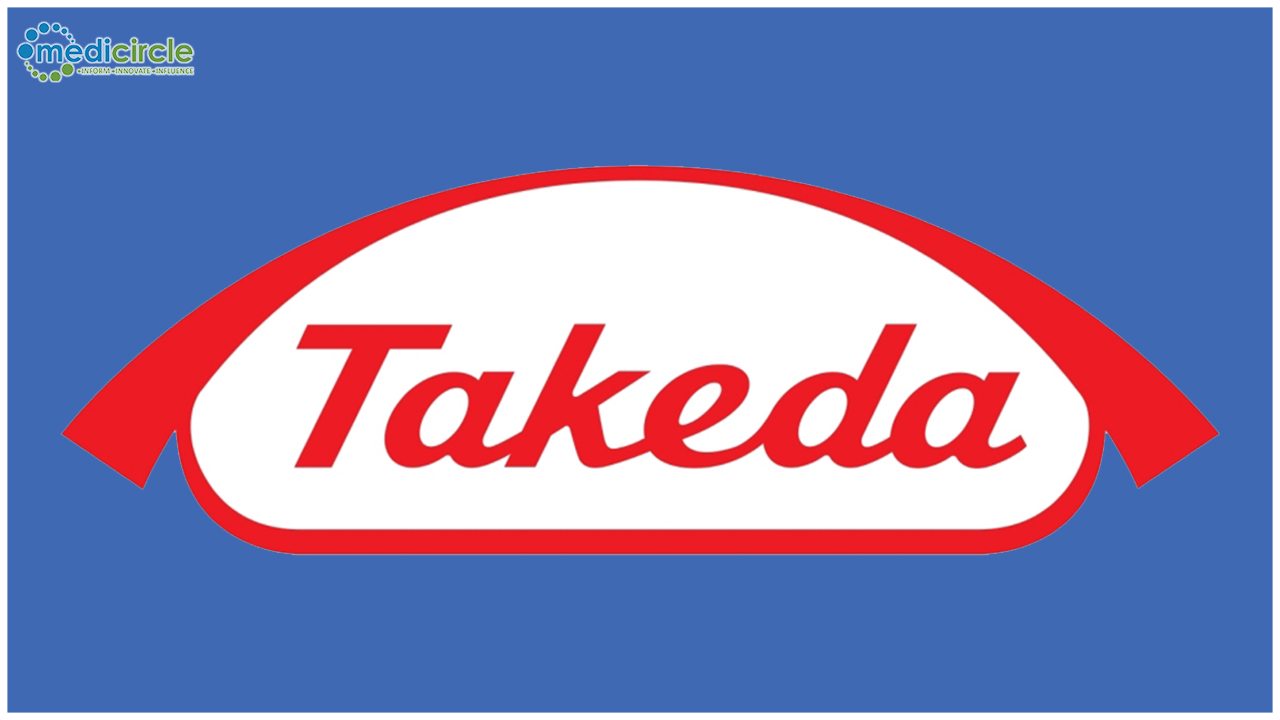Takeda Pharmaceutical Company Limited recently announced the results from the TOURMALINE-MM2 study designed to evaluate the addition of NINLARO™ (ixazomib) to lenalidomide and dexamethasone in newly diagnosed transplant ineligible multiple myeloma patients. The addition of ixazomib to lenalidomide and dexamethasone resulted in an improvement in median progression-free survival (PFS) of 13.5 months (35.3 months versus 21.8 months; hazard ratio [HR] 0.83; p=0.073); however, it did not meet the threshold for statistical significance. The safety profile associated with NINLARO from the TOURMALINE-MM2 trial was generally consistent with the existing prescribing information.
Results from the TOURMALINE-MM2 study will be submitted to an upcoming medical congress.
“There is a need for treatment options in transplant ineligible patients. We remain committed to advancing the field of multiple myeloma and continue to drive innovation through ongoing research and development,” said Christopher Arendt, Head, Oncology Therapeutic Area Unit, Takeda. “We are confident there will be numerous learnings from this trial and look forward to sharing these data with the community. We want to thank the patients and investigators for their participation in this important program.”
Investigators have been informed of the outcome and will discuss the potential impact with study participants. For patients currently enrolled in this study, it is up to the discretion of physicians to continue their current treatment.
About the TOURMALINE-MM2 Trial
TOURMALINE-MM2 is an international, randomized, double-blind, multicenter, placebo-controlled Phase 3 clinical trial, designed to evaluate NINLAROTM (ixazomib) plus lenalidomide and dexamethasone compared to placebo plus lenalidomide and dexamethasone, in 705 adult patients with newly diagnosed multiple myeloma who are not candidates for transplant. The primary endpoint is progression-free survival (PFS). Key secondary endpoints include rate of complete response (CR), pain response and overall survival (OS).
About Multiple Myeloma
Multiple myeloma is a life-threatening rare blood cancer that arises from the plasma cells, a type of white blood cell that is made in the bone marrow. These plasma cells become abnormal, multiply and release a type of antibody known as a paraprotein, which causes symptoms of the disease, including bone pain, frequent or recurring infections and fatigue, a symptom of anemia. These malignant plasma cells have the potential to affect many bones in the body and can cause a number of serious health problems affecting the bones, immune system, kidneys and red blood cell count. The typical multiple myeloma disease course includes periods of symptomatic myeloma followed by periods of remission. Nearly 230,000 people around the world live with multiple myeloma, with approximately 114,000 new cases diagnosed globally each year.
About NINLAROTM(ixazomib) capsules
NINLARO™ (ixazomib) is an oral proteasome inhibitor which is being studied across the continuum of multiple myeloma treatment settings. NINLARO was first approved by the U.S. Food and Drug Administration (FDA) in November 2015 and is indicated in combination with lenalidomide and dexamethasone for the treatment of patients with multiple myeloma who have received at least one prior therapy. NINLARO is currently approved in more than 60 countries, including the United States, Japan and in the European Union, with more than 10 regulatory filings currently under review. It was the first oral proteasome inhibitor to enter Phase 3 clinical trials and to receive approval.
NINLAROTM (ixazomib): GLOBAL IMPORTANT SAFETY INFORMATION
SPECIAL WARNINGS AND PRECAUTIONS
Thrombocytopenia has been reported with NINLARO (28% vs. 14% in the NINLARO and placebo regimens, respectively) with platelet nadirs typically occurring between Days 14-21 of each 28-day cycle and recovery to baseline by the start of the next cycle. It did not result in an increase in hemorrhagic events or platelet transfusions. Monitor platelet counts at least monthly during treatment with NINLARO and consider more frequent monitoring during the first three cycles. Manage with dose modifications and platelet transfusions as per standard medical guidelines.
Gastrointestinal toxicities have been reported in the NINLARO and placebo regimens respectively, such as diarrhea (42% vs. 36%), constipation (34% vs. 25%), nausea (26% vs. 21%), and vomiting (22% vs. 11%), occasionally requiring use of antiemetic and anti-diarrheal medications, and supportive care.
Peripheral neuropathy was reported with NINLARO (28% vs. 21% in the NINLARO and placebo regimens, respectively). The most commonly reported reaction was peripheral sensory neuropathy (19% and 14% in the NINLARO and placebo regimens, respectively). Peripheral motor neuropathy was not commonly reported in either regimen (< 1%). Monitor patients for symptoms of peripheral neuropathy and adjust dosing as needed.
Peripheral edema was reported with NINLARO (25% vs. 18% in the NINLARO and placebo regimens, respectively). Evaluate patients for underlying causes and provide supportive care, as necessary. Adjust the dose of dexamethasone per its prescribing information or the dose of NINLARO for severe symptoms
Cutaneous reactions occurred in 19% of patients in the NINLARO regimen compared to 11% of patients in the placebo regimen. The most common type of rash reported in both regimens was maculo-papular and macular rash. Manage rash with supportive care, dose modification or discontinuation.
Thrombotic microangiopathy, sometimes fatal, including thrombotic thrombocytopenic purpura/hemolytic uremic syndrome (TTP/HUS), have been reported in patients who received NINLARO. Monitor for signs and symptoms of TPP/HUS and stop NINLARO if diagnosis is suspected. If the diagnosis of TPP/HUS is excluded, consider restarting NINLARO. The safety of reinitiating NINLARO therapy in patients previously experiencing TPP/HUS is not known.
Hepatotoxicity, drug-induced liver injury, hepatocellular injury, hepatic steatosis, and hepatitis cholestatic have been uncommonly reported with NINLARO. Monitor hepatic enzymes regularly and adjust dose for Grade 3 or 4 symptoms.
Pregnancy- NINLARO can cause fetal harm. Advise male and females patients of reproductive potential to use contraceptive measures during treatment and for an additional 90 days after the final dose of NINLARO. Women of childbearing potential should avoid becoming pregnant while taking NINLARO due to potential hazard to the fetus. Women using hormonal contraceptives should use an additional barrier method of contraception.
Lactation- It is not known whether NINLARO or its metabolites are excreted in human milk. There could be potential adverse events in nursing infants and therefore breastfeeding should be discontinued.
SPECIAL PATIENT POPULATIONS
Hepatic Impairment: Reduce the NINLARO starting dose to 3 mgin patients with moderate or severe hepatic impairment.
Renal Impairment: Reducethe NINLARO starting dose to 3 mg in patients with severe renal impairment or end-stage renal disease (ESRD) requiring dialysis. NINLARO is not dialyzable and, therefore, can be administered without regard to the timing of dialysis.
DRUG INTERACTIONS
Co-administration of strong CYP3A inducers with NINLARO is not recommended.
ADVERSE REACTIONS
The most frequently reported adverse reactions (≥ 20%) in the NINLARO regimen, and greater than in the placebo regimen, were diarrhea (42% vs. 36%), constipation (34% vs. 25%), thrombocytopenia (28% vs. 14%), peripheral neuropathy (28% vs. 21%), nausea (26% vs. 21%), peripheral edema (25% vs. 18%), vomiting (22% vs. 11%), and back pain (21% vs. 16%). Serious adverse reactions reported in ≥ 2% of patients included thrombocytopenia (2%) and diarrhea (2%). For each adverse reaction, one or more of the three drugs was discontinued in ≤ 1% of patients in the NINLARO regimen.

 Multiple myeloma is a life-threatening rare blood cancer that arises from the plasma cells, a type of white blood cell that is made in the bone marrow.
Multiple myeloma is a life-threatening rare blood cancer that arises from the plasma cells, a type of white blood cell that is made in the bone marrow.




















.jpeg)












